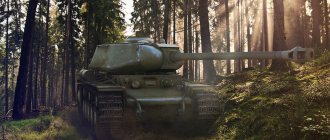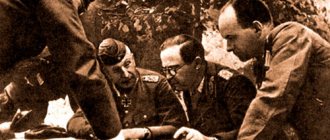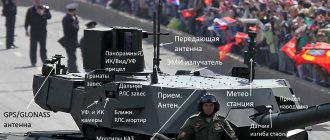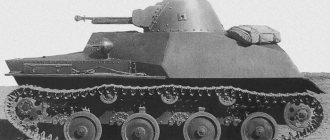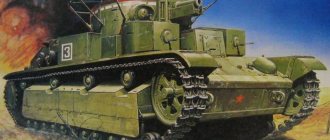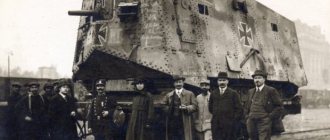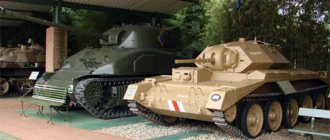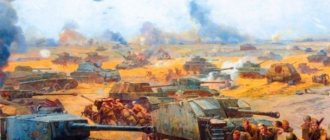Russian "Renault"
Russian "Renault"
The captured Renaults captured near Odessa prompted the Soviet government to decide to start producing tanks in the RSFSR. On August 10, 1919, by a joint decision of the Council of People's Commissars and the Council of Military Industry, the Sormovsky plant in Nizhny Novgorod was designated as a specialized enterprise - a manufacturer of tanks. The armor was to be supplied by the Izhora plant in Petrograd, and the engines by the AMO plant in Moscow.
On September 29, 1919, the Renault tank arrived at Sormovsky. It was a tank given to Lenin by soldiers of the 2nd Ukrainian Army and which turned out to be faulty. The car had been parked in Moscow since March and many of its parts were stolen.
To copy the combat vehicle and produce working drawings, by order of Tsentrobroni, a special team of designers was formed at the plant, consisting of TT. Krymov, Saltanov, Moskovkin and Spiridonov. To help them, a group of four people arrived from the Izhora plant, which was supposed to produce armored hulls for tanks, under the leadership of technologist Artemyev.
To solve the problem with the engine-transmission group, the AMO plant in Moscow was instructed to “redesign” the Fiat engine according to the type of the Renault tank engine. Engineer Kalinin was appointed responsible for the “motor unit”, he was assisted by engineer Pilunkovsky, and five designer-draftsmen.
On November 1, 1919, a special commission was created under the Council of Military Industry to resolve “all design issues related to the manufacture of tanks.” In addition to domestic engineers, it included two French specialists - Dem and Rozier, who had previously been involved in automobile production and sympathized with the Soviet regime (their characteristics indicate that one of them is a socialist). Moreover, engineer Rozier was entrusted with “making all the drawings and data for the new tank.”
The general management of the tank production work was carried out by the Armor Directorate of the State Military Institution, which was also the customer. The construction of tanks at the plant was monitored by the Commissioner of Tsentrobroni I.Kh. Gaugel, who very often solved all problems with the help of a Mauser and profanity. At the same time, largely thanks to the activity of Gaugel, who was very responsible about the work entrusted to him, it was possible to quickly “break through” the equipment and materials necessary for the construction of tanks.
The assembly of tanks began in December 1919 and proceeded very slowly and with great difficulties - there were not enough skilled workers, materials, raw materials, and food. Therefore, the required rhythm of work could not be achieved.
The first tank was ready only in August 1920. On September 1, Commissioner of Central Armor I.Kh. Gaugel sent a telegram to Moscow with the following content:
“I report that on August 31, 1920, the first tank was tested on the move.”
The first sample of the Russian Renault tank in the workshop of the Sormovo plant. August 1920. At the car are the engineers and technicians who supervised the design and assembly of the car, on the left is the Commissioner of Tsentrobroni I.Kh. Gaugel. Another Russian Renault (ASKM) is visible in the background.
General view of the first sample of the Russian Renault tank “Freedom Fighter Comrade. Lenin." Sormovo plant, August 1920. Please note that the tracks and some suspension parts are painted white (RGAE).
Tank “Russian Renault” “Freedom Fighter Comrade. Lenin", view from the right. Sormovo plant, August 1920. Please note that, unlike the French Renaults, the base of the turret cap was faceted and not cylindrical (RGAE).
Tank "Freedom Fighter Comrade" Lenin" during tests in the area of the Sormovo plant. August 1920. In the photo the car overcomes the wall (GANO).
However, during testing, many design and technological flaws were discovered in the design of the machine, which required its modification. It took more than two months to eliminate the shortcomings, and only on November 13 did the Russian Renault begin testing, which ended eight days later.
There is information in the literature that the first tank, called “Freedom Fighter Comrade. Lenin", sent to Moscow as a gift to the People's Commissar for Military and Naval Affairs Leon Trotsky. However, the author was unable to find confirmation of this in the documents. Most likely, it was not the tank itself that was sent, but its model.
Tank, “Freedom Fighter Comrade. Lenin" was armed with a 37-mm Hotchkiss SA-18 cannon, taken from the French "Renault" FT. It was planned to install a domestically produced 37-mm Hotchkiss naval gun on the remaining vehicles - according to the original plan, machine gun armament was not provided. But already on October 31, 1920, the Armored Department of the State Military Institution addressed the Council of Military Industry with a letter, which indicated that “arming a tank with one 3-mm non-automatic cannon is not enough to work in the conditions of the Russian front, therefore the installation of one machine gun is also necessary.”
The 37-mm Hotchkiss guns were supplied from the Putilov plant, where they were repaired. Hotchkiss machine guns, taken from white British MK-V tanks, arrived from Moscow.
As of March 24, 1919, the state of work on tanks was as follows:
“Sormzavod is finishing the entire order for tanks. Completely assembled - 10 tanks, assembled without engines - 4 tanks, assembled - 1.
The shipment of ready-made ones is delayed by the installation of machine guns, since recently it was decided to install a Hotchkiss machine gun in the tank’s cannon turret. This solution is feasible and rational. The first four installations will be ready no later than April 10, after which the tanks will be immediately sent to Moscow. The final assembly of the latter is delayed by the lack of motors.”
It is interesting to provide data on the readiness and condition of tanks in the spring of 1921. The document looked like this:
“There are 10 guns in total, 2 tanks are ready, 5 is 90% ready, 3 is 40% ready.”
It should be added to the above document that the last four cars subsequently received the following names: No. 12 - “Ilya Muromets”, No. 13 - “Storm”, No. 14 - “Kerch” and No. 15 - “Victory”.
It should be said that the engineers of the Sormovo plant tried to improve the maneuverability of the tanks. To do this, a new gearbox was installed on car No. 7 “Red Fighter” - it is described in the table below.
Statement sheet of Renault M tanks manufactured by the Sormovo plant on March 20, 1921.
Tank "Russian Renault" during maneuvers in the Moscow Military District. 1922 The vehicle's cannon and machine gun armament (TSMVS) is clearly visible.
On March 28, 1921, I. Shukalov reported to the Council of Military Industry:
“High speed test. Tank No. 7 was equipped with a new gear to increase speed, which was achieved in two ways.
A). The 4th gear of the gearbox has been increased to increase speed by 1.8 km.
b). The final drive has been increased to increase speed by 2.6 km, for a total of 4.4 km.
19/III p. conducted the test. As a result, it turned out that the new transmission justifies the assumptions to a very small extent.
Tank No. 7 increased the speed from 8 to 10 km instead of the design 12.5 at an average engine speed of 1400. Tank No. 6, with the same gear and huge revolutions (2000), gave almost the same increase. After the test, an order was given to distribute the combined speed increase from No. 7 to two tanks, which was accomplished with continuous operation in 40 hours.
21/III p. The tanks entered the second test: No. 7 with an increased final drive, and No. 6 with an increased 4th gear of the gearbox. Both tanks developed almost the same speed within the same limits as the 19/III. According to some general characteristics, engine No. 7 pulled weaker than No. 6, which explains the greater speed of No. 6 (9.87 km/h for the first and 10.26 km/h for the second).
From this test it is clear that the engine power is almost at its limit, so increasing the final drive, which reduces the gear ratio of all four speeds, is irrational.
As for increasing the 4th speed, I consider this desirable, since although the tank with normal gears developed the same speed of approx. 10 km/h, but this increase occurs due to a huge number of revolutions, which is not suitable for long-term operation.
The power transmission makes it possible to use this speed at engine speeds close to normal, i.e. about 1500 rpm. For steep road obstacles and climbs, the first three speeds remain in the same conditions.”
But, as mentioned above, subsequently a regular gear was installed on tank No. 7 instead of an “overdrive.”
Tank "Russian Renault" on Red Square during the parade. Moscow, November 7, 1928. The installation of weapons is clearly visible, as well as the tactical designation adopted for tank units of the Red Army in 1925 (TsMVS).
Problems with weapons caused a delay in the delivery of tanks. The first three Renault Russians (No. 1, 2 and 4) were sent to Moscow in May 1921, but problems arose with the rest. Thus, on June 2, 1921, the head of the armored forces of the Red Army reported to the Council of Military Industry of the RSFSR that five tanks were not accepted due to the fact that Hotchkiss guns were not mounted on them. The fact is that for the seven vehicles (in addition to the three sent) that had these guns, the Sormovo plant needed to produce a number of parts for mounting artillery systems in the turrets. Therefore, the person overseeing the armor at the factory received an order to send the vehicles “without the armor plate of the tank turret carrying the installation, as well as without the gun installation itself.” As the installations were finally manufactured, the Sormovsky plant had to send them out.
In June and early July, ten more Renault Russians were shipped to Moscow. As of July 15, 1921, the situation with tanks at the Sormovo plant was as follows: “The next tanks were handed over to the authorized representative of Central Armor on June 21. Thus, only two tanks No. 7 and 8 were not delivered, and on No. 7, instead of the supposed reinforced type engine, a normal type engine was installed.
The only things missing from the outside were a radiator from the AMO plant for a model tank, and five 37-mm Hotchkiss guns from the GAU.”
Thus, the last Renault Russian tanks were completed in the summer of 1921 - it took more than a year to build 15 tanks from the moment the decision was made. In conditions of the Civil War, devastation and broken industrial ties between enterprises, this is quite a good indicator. It should be added that five Renault Russians never received the artillery weapons they were entitled to.
The “model” tank mentioned in the latest document is the French Renault FT, which served as the standard for the construction of Sormovo vehicles. Plant documents for August 1921 state that “the model tank has been repaired and is being used as a tractor.”
A delegation of Moscow workers visiting tank crews. Around 1923-24. In the background is the Russian Renault tank - the mixed cannon and machine gun armament is clearly visible, as well as the emblem of the Red Army armored forces painted on the turret (ASKM).
In later documents of the Sormovo plant, the name of the restored model Renault is found - “Souvenir”. But in the correspondence of 1920–1921 between the enterprise, the Council of Military Industry and the command of the armored units of the Red Army, this name does not appear, and this vehicle is simply referred to as a “model tank.” Most likely, “Souvenir” is the unofficial name that the factory workers called this car. And in subsequent years, when they were collecting material on the history of the first Soviet tank, someone remembered this and wrote it down.
The Russian Renaults differed from their French prototype by the increased size of the engine compartment (the Fiat engine was slightly larger in size than the Renault engine), mixed weapons and lower quality workmanship.
"Renault Russians" did not participate in the Civil War - they entered service with tank detachments of the Red Army only in 1921. Several machines were used as tractors for plowing fields. So, on the basis of the order of the RVSR No. 1375 on February 7, 1922, “comrade. Shibanov began the formation of the 6th tank detachment.” 14 days were allotted for everything, and the unit was supposed to receive five Renault tanks and one car. The documents on the formation of the detachment stated:
“It had to be staffed by personnel familiar, if possible, with agricultural work. A detachment was intended to plow fields in the hungry Volga region, at the disposal of the head of the armored forces of the Volga Military District.
Renault tanks from the light tank flotilla of the tank squadron. Moscow, Lefortovo, autumn 1924. In the center stands Saltykov, deputy chief of the combat unit. Please note that the far right and second from the left are “Russian Renaults”; the ball mounting of the machine gun in the turret and the faceted base of the cap (CMVS) are clearly visible.
The recruitment of personnel was carried out in the tank division, the entire command staff was transferred from the reserve of the tank division, with the exception of two tank commanders and an adjutant - a former officer of the old army, all graduated from the courses of the Higher Armored School for the training of Red commanders. All but one tank commander served in the old army, four were members of the Russian Communist Party (Bolsheviks).”
On February 22, 1922, the detachment received five Renault Russian tanks from the garage of the auto-tank armored brigade: No. 1 “Freedom Fighter Comrade. Lenin", No. 2 "Paris Commune", No. 9 "Proletarian", No. 13 "Storm" and No. 15 "Victory". The next day, the vehicles took part in the parade on Red Square, and on March 4, the detachment (55 people, five tanks, four Hotchkiss guns) was sent to Saratov, where it arrived ten days later. On April 8, 1922, the tanks unloaded at the Semiglavy Mar station (now the Taskalinsky district in Kazakhstan), where after some time they began work.
In domestic literature, the Sormovo-made Renault is sometimes referred to as “KS” (“Krasnoye Sormovo”), which is not correct - the company received the name “Krasnoye Sormovo” only on November 17, 1922. In documents of the 1920s and 1930s they were referred to as “Russian Renaults”, “Renault Russians” or M (“small”).
Russia on the rise
From 1908 until the revolutionary events, the country showed unprecedented economic growth. Economist Edmond Tray predicted: “If the great European nations develop between 1910 and 1950 in the same way as they did between 1900 and 1912, then by the middle of this century Russia will be the largest in Europe.” both in terms of political and financial-economic aspects.”
This opinion was confirmed by numbers. Between 1890 and 1913, the productivity of domestic industry quadrupled, and the number of established joint stock companies increased by 132% from 1910 to 1913. The size of the national income of the Russian Empire was the fourth in the world after the USA, Germany and Great Britain. And in terms of its growth rate, the country was among the leaders. On average, Russia's contribution to world income was approximately 7.4%, while the country's share of the global economy is now estimated at only 3.3%.
The coal, oil, gold mining and metallurgical industries developed especially actively before the First World War. Russia accounted for half of the world's egg exports and up to 80% of flax production.
And although the Russian Empire could not boast of a good GDP per capita, its taxes were among the lowest in Europe.
Perhaps the best year in Russia from an economic point of view was the pre-war 1913, which is still called “golden”. And then the decline began. Men were called to the front, their jobs were taken by women. The qualifications of employees, incomes, and production volumes fell. The only exceptions were those industries that worked for the front. By 1917, the country was on the verge of a fuel, transport and food crisis. There were mass strikes, State Duma Chairman Rodzianko called the situation catastrophic. The economy, which flourished in peacetime, was not ready for the military load.
Meanwhile in Rybinsk
The main engine of economic life until 1916 was the Corn Exchange. The related flour-grinding industry was actively developing, which in 1913 accounted for 73% of the gross product and every fifth worker. Sawmilling and rope production took second and third place. Of the industrial enterprises in the city, there was a shipbuilding plant of the Nobel brothers partnership and the numerous factories of the merchant Zhuravlev already mentioned above.
Oksana Gozhalimova: “ At the beginning of the 20th century, the main industrial enterprise of the city were railway workshops. This was the elite of Rybinsk, a labor aristocracy who lived in a special position. They were the first to actively cooperate with parties - the Bolsheviks, the Mensheviks - they were the initiators of the strike movement and walkouts. They were the first to hear news from Petrograd.”
Since 1916, the work of the Bread Exchange was suspended: trade in bread became a state monopoly. But with the fading of one heavyweight, a new one begins to emerge on the very outskirts of Rybinsk. Although the events of the first years of his life did not promise such glory at all.
"GAZ-3"
By mid-1917, the project to build an automobile plant in Rybinsk was half completed, and some of the equipment had already arrived. But, alas, it was not possible to bring the plans to completion. The October Revolution found the enterprise unfinished, and funding was curtailed.
However, even at this time the plant was not idle. In March 1918, Soviet power was finally established in the city, meanwhile the First World War gave way to the Civil War. The workers independently assembled the repair equipment, and already in the summer they sent the first batch of restored trucks to the front. In the fall of the same year, the plant was nationalized, even Vladimir Lenin noted the efforts of the enterprising citizens. In his book “Engine Builders,” Pavel Derunov quotes the leader’s words at a meeting of the Supreme Economic Council:
“The Rybinsk comrades are taking up the solution of the most important and most urgent tasks of the current time correctly, and I ask the representatives of the Soviet government and the workers’ organizations of Rybinsk to accept my wishes to work even more energetically and achieve the best success in this field.”
Did the French lose the wheels of history due to such a sharp turn? Expert Oleg Malsagov believes no:
“By and large, if I were Renault, I would do the same. The coming to power of the Bolsheviks at the end of 1917 was extremely unexpected for many. And in 1915-1916, most political trends did not pose a threat to business; at that moment, the only risk zone was war. Both Russia and liberal France understood perfectly well that the war would end sooner or later, but the market would remain, and it would need tractors, trucks, and airplanes. From a business point of view, it was a good deal, since France contributed its technology to the plant, and Russia covered the rest of the costs. Moreover, history shows that the French were right. Subsequently, they returned to our country in the fifties. And by the eighties, French technologies in the automotive industry became one of the key technologies for the Soviet automobile industry, and the USSR paid for them.”
As a result, the planned machine-building enterprise, which never produced a single car, was retrained as a repair company. And later it received a new name - State Automobile Plant No. 3. Ahead was the NEP and the first years of the young Soviet government. But this is a topic for the next material.
Remember the key events of this decade with flashcards:
Scroll through the slider to see all ten cardsIn preparing the article, information was used from the books “Engine Builders” (author P.F. Derunov), “Saturn 2010: Events and People” (prepared by the press service of NPO Saturn).

